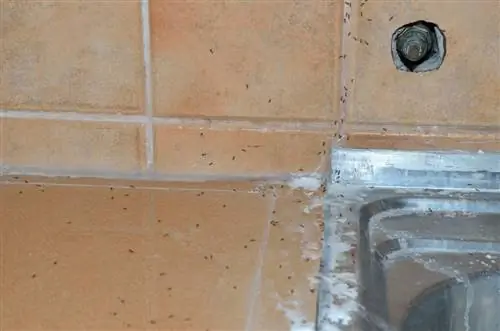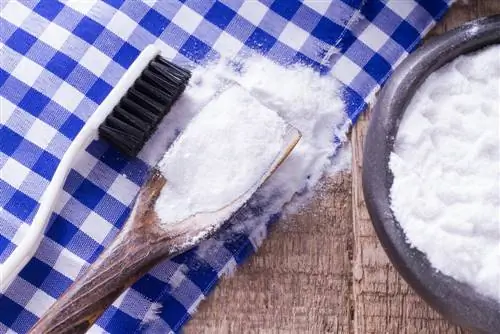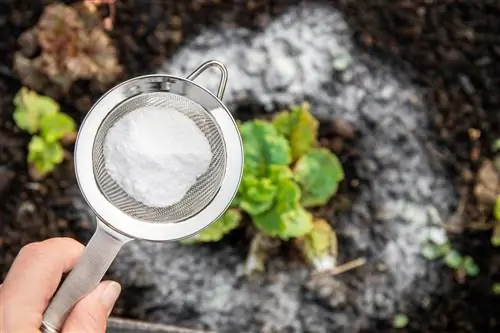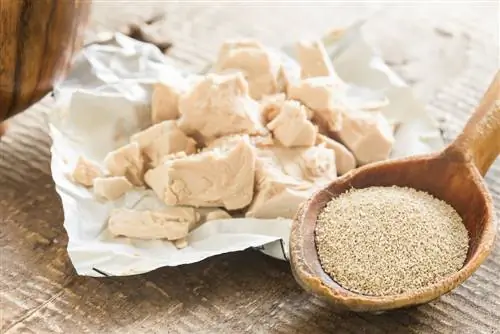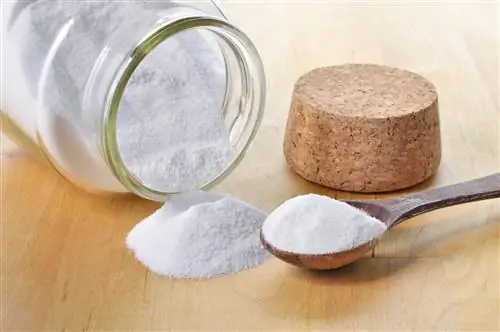- Author admin [email protected].
- Public 2023-12-16 16:46.
- Last modified 2025-01-23 11:22.
In addition to numerous home remedies, baking soda is the number one way to combat ants. Many people don't know how the raising agent works and can't explain why the powder doesn't work. The behavior of the ants and their body structure provide the answers.
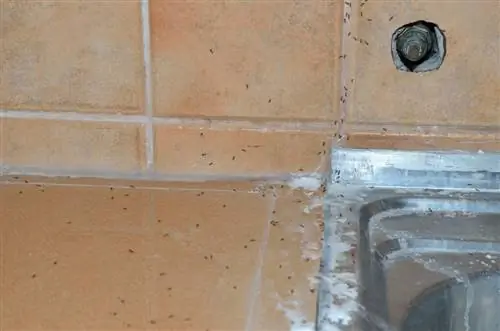
Does baking soda work against ants?
Baking soda can disrupt enzyme function in ants and cause death if they eat it. To effectively control ants, offer them an attractive bait mixed with baking soda (sodium bicarbonate). A concentration of 5% has been shown to be effective in studies.
Does baking soda help against ants?
The home remedy is used to combat ants, but there are always disappointments. Baking soda seems to work in some cases, while in other situations it has no apparent effect. There are good reasons for this, because baking soda only helps under certain conditions and when used specifically. It also matters which baking powder you use.
Composition
The raising agent is composed of a CO2 source and an acidulant. Sources of carbon dioxide are sodium hydrogen carbonate (short: baking soda or NaHCO3) or potassium hydrogen carbonate. Various substances are used as acid sources. Cream of tartar baking powder contains natural tartaric acid, which is produced during the production of sparkling wine. Conventional baking powders contain phosphate as an acidulant.
How does baking soda work?
The baking soda dissolves in water with a weak alkaline reaction. The heat in the oven, deep fryer or waffle iron causes baking soda to react with the acid, releasing carbon dioxide. This process weakens the alkaline effect of baking soda somewhat. The reaction can be recognized by the small gas bubbles that rise in the dough and loosen it up. A shoot is achieved similar to when using yeast.
Misconceptions
It is often suspected that baking soda causes a similar effect on ants. Baking soda is said to expand in the stomach after absorption, causing the insects to eventually burst. However, this assumption is a myth.
This theory may come from deer horn s alt, which was also used as a baking agent in the past. This is a source of toxic ammonia and is therefore harmful to he alth if consumed immediately.
The “Regulations Book for Druggists” from 1914 describes sourdough as an effective ant killer. The yeasts are said to ferment in the ant stomach, causing the insects to bloat and die. This could also be a possible reason why baking soda is suspected of causing ants to burst.

Why does baking soda still help against ants?
US researchers discovered in 2004 that baking soda is actually poisonous to ants. They suspected that the ants' internal pH value increased unfavorably. This impairs the function of certain enzymes, which is why the ants die after eating baking soda. Ants probably ingest the powder through their tracheae or when cleaning their pollinated antennae. The insects eat the powder for a reason. An attractive bait mixed with baking soda can entice them to eat.
Excursus
Ants are trachea animals
Tracheas are particularly important for life in the countryside. They are air channels that run through the entire body and supply the cells with oxygen. In some places they flow outwards. In ants, these openings are located on the chest. These powerful respiratory organs can be actively closed. If they are clogged with tiny particles, the insects can no longer breathe.
Test results
In the experiments, the ants were forced to stay permanently on the surfaces dusted with baking soda. Red fire ants and Argentine ants were examined. Four milligrams of baking soda were spread per square centimeter. After six days, approximately 99 percent of all insects exposed to a concentration of 152 mg of sodium bicarbonate were dead.
The ants were also given a bait made from sugar water and varying concentrations of NaHCO3. If this was five percent, half of the insects died after six days. The highest mortality rate was observed at this concentration.
Tips for use

Baking soda only harms the animals that have eaten it themselves
It is not certain that baking soda effectively combats the ant plague. You can use the product to kill ants directly, but not the queen and brood in the nest. If you want to make a feeding bait, the concentration of the baking soda is crucial to its effectiveness. Baking powder with potassium hydrogen carbonate has no corresponding effect.
Test the concentration at which the ants accept the bait and reduce or increase the concentration if necessary. Bait made from liver sausage or tuna is generally well accepted by ants. However, different baking soda concentrations may be necessary here than in a solution with water, baking powder and sugar.
What you need to know about baking powder:
- must contain sodium bicarbonate
- pure baking soda works more efficiently because the alkaline effect is not weakened
- spread on an ant trail ineffective
- Insects can avoid pollinated surfaces
- Effects are visible when ants are sprinkled directly
What to do against ants?
It is difficult to find effective home remedies other than baking soda that actually kill ants. Various agents have a deterrent effect on ants. Such substances can be used in ant trails. They do not help if there is a nest in the building.
Dusty Barriers
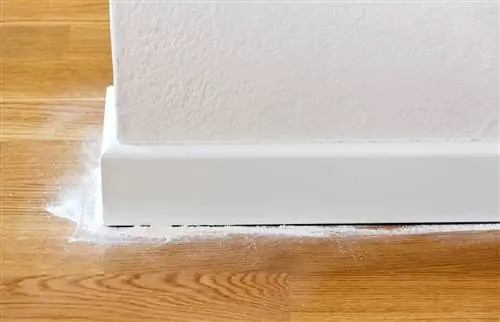
Plaster or chalk powder as well as baby powder prevent ants from entering
Ants generally avoid surfaces that are covered with dust. The particles can enter the breathing openings and block tracheas. Such barriers only work if there are high concentrations of particles in the air we breathe. Outdoors, the barrier effect quickly weakens as winds carry away the fine dust particles. In the apartment, ants quickly find a detour around the applied line. Therefore, you should use this method at the entrance gates and ensure that the ants cannot find other access to the apartment.
Suitable means:
- gypsum dust
- Baby powder
- Chalk
Fragrances
Various intensely smelling substances confuse the ants' sense of direction. The insects use their antennae to find scent traces of their fellow species. This is how ant trails form. If an impenetrable scent barrier covers the pheromone markings, the ants can no longer find their way back. Here, too, the ants get to the old road via detours, which is why you should use scents directly at the access gaps.
What ants don't like:
- Cinnamon: confuses ants when the powder is spread thickly on the ant trail
- Eucalyptus oil: can be used as a cleaning agent to remove marks
- Lavender: fresh herb in front of entrances repels ants
Fighting flying ants
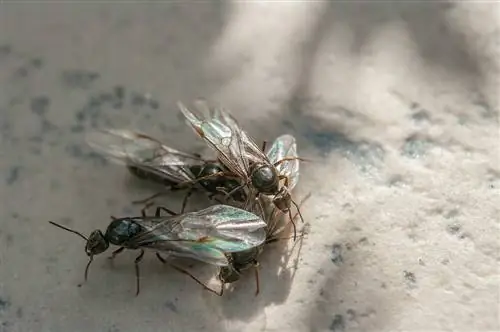
Flying ants in the house can indicate an indoor ant colony
You can easily protect yourself against winged ants from outside by hanging fly screens (€5.00 on Amazon) in front of the windows. It is more problematic if the insects appear behind the cupboard with wings or crawl out of cracks on the ceiling and floor. They indicate a nest in the partition walls and beams. The males swarm out to find mates from other colonies. Ants avoid inbreeding and do not mate within a colony. Let the ants escape from the apartment and focus on the existing nest.
Flying ants are problematic when they crawl out of the walls.
Remove nests
To ensure that no more ants settle in the house after successful control, nests and scent markings must be eliminated. New colonies quickly discover the optimal nesting opportunities via pheromone trails. Since there is no competition from the old colony, there are no longer any obstacles in the way of the new colony and they take over the nest.
Tip
Don't let it get to that point and seal cracks in the facade and gaps in doors and windows.
Relocate nests?
It is often recommended to relocate the ants using a flower pot. However, this method does not work for most species. It can be used on earth-dwelling insects after the burrow has been rendered uninhabitable by heavy rain.
Fill a clay pot with crumpled and slightly moistened newspaper and place it over the nest immediately after rain on sunny days. The ants will begin to relocate their brood to the drier environment. Place the pot at least ten meters away so that the ants can no longer trace the path back.

Renovation necessary
Replace affected roof beams with new ones. Some species of ants settle in built-up wood that has already been damaged by moisture, fungi and harmful insects. Thermal insulation can also provide ideal conditions if it has been compromised by moisture. Such materials can no longer fully fulfill their actual function and should be replaced for this reason. Pay attention to possible sources of moisture in the kitchen and bathroom and eliminate them. Ants prefer moist environments.
Common species in their habitats
Ants are part of nature. No garden is free of ants and so the insects quickly find access to homes. Buildings that are surrounded by densely overgrown beds or are located near forests are particularly at risk. Ants in the house and garden are a symptom and indicate very specific factors.
Tip
At the German Ant Protection Observatory you will find addresses of experts who can help you with the identification.
Earth Dwellers
Some species of ants build their nests underground in the substrate. They feed on the honeydew that root lice produce. An ant infestation in the lawn indicates that the grass roots are infested with lice. If the insects find abundant food sources, they can also settle in flower pots or greenhouses. The insects get into the apartment unnoticed when the buckets are brought from the balcony into the apartment to overwinter.
| scientific | Worker Size | Appearance of the workers | |
|---|---|---|---|
| Yellow meadow ant | Lasius flavus | two to 4.5 millimeters | varies between pale yellow and brown-yellow |
| Black garden ant | Lasius niger | three to five millimeters | dark brown to black |
| Yellow thief ant | Solenopsis fugax | 1, 5 to three millimeters | light yellowish |
Wood and tree dwellers

Many species of ants live in rotten wood
Many species have specialized in living in dead wood. They are tied to trees and settle in already damaged wood. If the garden has old fruit trees, the insects find optimal nesting opportunities and food at the same time. They feed on fruit and honeydew from aphids.
It is not uncommon for such species to nest in the house. Built-in wood looks attractive if it is affected by moisture and is already damaged. Ants prefer to look for environments with a humid microclimate, otherwise their brood will dry out. That's why they like to build their nests in partition walls of the kitchen or bathroom.
| scientific | Worker Size | Appearance of the workers | |
|---|---|---|---|
| Brown ant | Lasius brunneus | 2, 5 to four millimeters | Trunk reddish brown, head and abdomen darker |
| Black carpenter ant | Camponotus herculeanus | usually nine to twelve millimeters | black, legs dark red |
| Shiny Black Carpenter Ant | Lasius fuliginosus | four to six millimeters | deep black, shiny |
| Red Garden Ant | Myrmica rubra | four to six millimeters | reddish brown, dark brown on the head |
Frequently asked questions
What is behind the myth of baking soda against ants?
Baking powder expands when exposed to heat in the dough, causing gas bubbles to form. It is often assumed that a similar effect occurs in the ant stomach. This assumption is not true. Rather, baking soda appears to be responsible for the death of the ants. Researchers believe this causes a change in the pH of the hemolymph. Certain enzymes no longer function, causing the ants to die.
Why don't home remedies against ants work for me?
On the one hand, the insects are very picky and do not eat all the sweet poisons that are offered to them. They also look for alternative detours when a substance hinders their ant route. The concentration of certain resources also determines success. If fragrances or feeding toxins are not concentrated enough, they will not be effective. If the dosage is too high, the deterrent effect is present. However, ants also avoid feeding poison if the substances are too concentrated.
How can I protect myself from ants?
Take preventative measures and close all entry gates. If there is already a nest in the building, more complex measures are necessary. It won't help if you just fight the ant infestation. Reconsider all options for renovation. The affected building materials are usually already damaged. The effects of moisture, harmful insects and fungi have done the preparatory work for the ant nest.
Why do ants keep coming back?
The insects are strongly guided by smells. This is how they find mating partners, other peoples and food sources. If an ant colony has been eradicated, scent traces usually remain. This attracts more ants, which settle in the old nest if there is no competition. Ant trails are also used again and again if the pheromone markings have not been thoroughly removed. This also applies to detours. The insects first use remote routes before finding the shortest route.
Why do I have to identify the species of ant in order to combat them?
Each species has different habitat preferences. Not all ants nest directly in the house once an ant trail has formed. There are both terrestrial and wood-dwelling species that prefer different food sources. In addition, not all ants respond equally well to the different control agents. The brown ant is often unimpressed when typical control agents are used.

